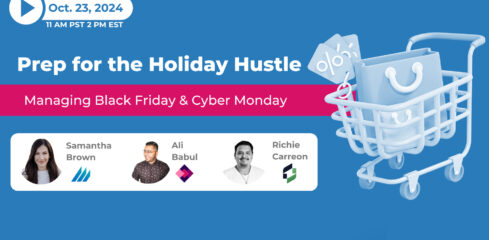
In the dynamic world of ecommerce, overselling is a term that’s no stranger to industry experts but is feared even among the most experienced of sellers. Overselling can send your business spiraling into a vortex of customer dissatisfaction and lost opportunities. Finale Inventory is here to provide strategies to avoid overselling, helping you understand its pitfalls and how to navigate them effectively.
Unpacking Overselling: Not Worth the Risk
At its core, overselling’s definition is selling more items than you have in stock. We know that overselling has a negative impact and can send your business, let alone inventory management, crashing to the ground. You may think you can replenish your inventory before your customer realizes there’s a delay with the product, but if lost, the damage of disappointing your customers is not worth the benefit of the perceived profitability with a product constantly being out of stock, and that will affect your bottom line.
Pitfall 1: The Potential for Lost Sales
Speaking of your company’s bottom line, the first pitfall is the potential for lost sales. According to a recent study in Harvard Business Review, a significant percentage of customers, estimated between 21% to 43%, will choose to visit another store to purchase an item they originally intended to buy if it’s out of stock at the store they are currently shopping at. This not only results in a lost sale but also strengthens your competition’s business and benefits their bottom line. You don’t want that. To prevent this on your webstore, consider implementing a pre-order system instead of a backorder system. Pre-ordering and allowing for backorder sales allow customers to order items that are not yet in stock but are guaranteed to be available at a future date, which then can keep your cash flow steady and help you with demand forecasting using the product’s sales data.
Given that most presales aren’t physically in your inventory yet, Finale’s system can be configured to automatically generate a purchase order (PO) with enough stock to cover you for the next order period, including the number of units you’ve pre-sold.
In addition, by clearly communicating the expected availability date to customers and keeping them informed about their order status, you can maintain customer satisfaction and prevent them from turning to competitors. This strategy not only helps retain sales but also builds anticipation and excitement around your products, which can enhance customer engagement and loyalty.
Another facet to consider is your advertising strategy. Promoting products that run out of stock while ads are still running can be detrimental to your business. You’re essentially paying for clicks that you can’t fulfill due to a lack of inventory. This is especially true for webstores, because, unlike some marketplaces like Amazon, preordering is not an option and so be sure to understand where your inventory lies before turning ads on.
This underscores the importance of synchronizing your sales efforts with your inventory management: whether for day-in, day-out sales, or for promotional periods. It’s crucial to have up-to-the-minute inventory tracking systems, like Finale Inventory, in place that can proactively alert you when stock levels are low. With Finale, our system will send reorder notifications to your email, warning you when minimum levels are reached. This way, you can pause or adjust your advertising campaigns accordingly, as well as move forward with issuing new purchase orders.
Finale offers the capability to push the quantity of stock you’re expecting to receive to your webstores. This means you can effectively presell inventory that’s currently on order from your manufacturer or vendor. By leveraging these features, you can manage your inventory more effectively, mitigate the risks of overselling, and maintain a steady flow of sales.
These strategies ensure that you’re able to meet customer demand promptly, maintain customer satisfaction, and make the most out of your advertising spend.
Pitfall 2: The Strain on Your Supply Chain
The second pitfall is the strain on your supply chain. Overselling can lead to a rush to replenish inventory, which can put undue pressure on your suppliers and disrupt your operations. Studies show that 72% of stock-outs are a result of ineffective in-store ordering and restocking strategies. This can lead to increased costs and decreased efficiency within your warehouse. If you need to rush the product from your supplier, you’ll likely also face extra fees and costs.
To avoid this, it’s crucial to have a robust inventory management system, which provides on-demand updates on stock levels to help you understand when you’re nearing the point of overselling and need to reorder. Advanced systems can even predict demand based on historical data, allowing you to plan your inventory needs with greater accuracy.
Moreover, implementing strategies like setting reorder points, maintaining safety stock, and having a pre-order system can help mitigate the risks associated with running out of stock.
Building strong relationships with your suppliers is equally important. Regular communication and good rapport can often lead to faster response times when you need to replenish stock quickly. Having multiple suppliers for the same product can also provide a safety net if one supplier can’t meet your demand.
Maintaining a safety stock, a small surplus of inventory kept on hand to guard against variability in market demand or supply delays, can help prevent overselling and ensure you can meet customer demand even during unexpected sales spikes.
Finale offers a feature called the “Include Supplier Quantity” option. This allows you to add a specific quantity to your inventory in our system, which Finale will then permit you to sell, even if you don’t physically possess that inventory yet. This can be particularly useful when you’re confident about incoming stock and want to start making sales immediately or when you’re running preorder campaigns.
Efficient supply chain management, strong supplier relationships, and accurate demand forecasting are crucial to maintaining adequate stock levels and minimizing the financial impact of stockouts.
Pitfall 3: The Risk to Your Brand’s Reputation and Customer Retention
It should come as no surprise that the third pitfall of overselling is the risk of damaging your brand’s reputation and customer retention. In an age where customer reviews can make or break a business, failing to deliver on promises can lead to a barrage of negative feedback, which can erode trust and deter potential customers, impacting your profitability. Not only can a bad review prevent businesses, but customers who have a negative experience are also less likely to return for future purchases, thus harming your business.
To mitigate this risk, transparency is key. If overselling is unavoidable, communicate with your customers via SMS messaging or email. Let them know there might be a delay, offer alternative products, or provide discounts for the inconvenience. This can turn a potentially negative experience into an opportunity to demonstrate excellent customer service. In a recent survey, 80% of respondents strongly recommended informing customers about potential stockouts as it gives the customer insight into what is happening behind the scenes improving your relationship with them by creating an open line of communication. This contradicts the common belief that stockouts negatively impact brand loyalty.
We’ve already spoken about getting ahead of stockouts. Should you find yourself in an active out-of-stock situation, this is when you can implement a backorder (or reorder) process to manage inventory and meet customer demand. The first step in this process is to select an inventory management software that supports reordering and integrate it with your sales channels, providing near real-time inventory updates. With a more advanced tool, you can even get reorder notifications sent right to your email, reminding you of low stock quantities.
Finale Inventory makes stock reordering fast and stress-free, always with the goal of getting you ahead of any potential issues. By continuously reporting up-to-the-minute inventory levels, the platform also enables you to set reorder points for each product so that when the stock count goes below the threshold, Finale can auto-populate a purchase order for you to send to your supplier.
To get ahead of stockouts, Finale allows you to define your backorder settings for min (and max) quantity for reordering, as well as denote the lead time from the supplier.
While a backorder system can be a valuable tool for managing inventory and meeting customer demand, it’s not a cure-all for inventory issues. It’s equally important to focus on improving inventory forecasting and supply chain management to minimize the need for backorders in the first place.
Striking the Balance in eCommerce
While overselling can be a sign that your products are in demand, which is a good thing, overselling is not good for your business if you don’t plan around the pitfalls. By being transparent with customers, implementing robust inventory management systems, and considering alternatives like preordering, you can navigate the tightrope of overselling and turn potential pitfalls into opportunities for business growth and customer satisfaction. Remember, in ecommerce, balance is key.
Finale Inventory is a leading provider of cloud-based inventory management solutions designed to support businesses across various industries. Our platform offers fast, reliable sales channel syncs, warehouse management, purchasing and replenishment, and accounting features.
For more information, talk to our team today!





